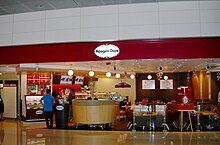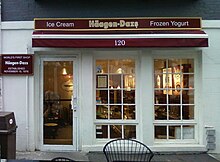Häagen-Dazs
 | |
 | |
| Company type | Subsidiary |
|---|---|
| Industry | Retail |
| Founded | 1960 in Bronx, New York, U.S. |
| Founder | Reuben and Rose Mattus |
| Headquarters | Minneapolis, Minnesota, U.S. |
Number of locations | 900+ |
Area served | Worldwide |
| Products | Ice cream |
| Owners |
|
| Website | www |
Häagen-Dazs (US: /ˈhɑːɡəndæs/ HAH-gən-dass, UK: /ˌhɑːɡənˈdɑːz/ HAH-gən-DAHZ)[1] is an American ice cream brand, established by Reuben and Rose Mattus in the Bronx, New York, in 1960. Starting with only three flavors: vanilla, chocolate, and coffee, the company opened its first retail store in Brooklyn, New York, on November 15, 1976.[2] The Pillsbury food conglomerate bought Häagen-Dazs in 1983, and now the brand is sold worldwide. Their product offerings include ice cream cartons, ice cream bars, ice cream cakes, sorbet, frozen yogurt, and gelato.[3]
History
[edit]
Häagen-Dazs's founder Reuben Mattus was born in Poland in 1912 to Jewish parents. His father died during World War I, and his widowed mother migrated to New York City with her two children in 1921.[4] They joined an uncle who was in the Italian lemon-ice business in Brooklyn. By the late 1920s, the family began making ice pops, and by 1929, chocolate-covered ice cream bars and sandwiches under the name Senator Frozen Products on Southern Boulevard in the South Bronx, delivering them with a horse-drawn wagon to neighborhood stores in the Bronx.[5][6]
The Senator Frozen Products company was profitable, but by the 1950s the large mass-producers of ice cream started a price war,[7] leading to his decision to make a heavy kind of high-end ice cream. In 1959, he decided to form a new ice cream company with what he thought to be a Danish-sounding name, Häagen-Dazs, as a tribute to Denmark's alleged exemplary treatment of Jews during World War II,[5] a move known in the marketing industry as foreign branding. Rose Mattus would dress up in fancy clothing to distribute free samples, giving the ice cream an air of sophistication and class.[7]
The Pillsbury Company bought Häagen-Dazs in 1983. In 1999, Pillsbury and Nestlé merged their U.S. and Canadian ice cream operations into a joint venture called Ice Cream Partners. General Mills, in turn, bought Pillsbury in 2001 and succeeded to its interest in the joint venture.[8][9] That same year, Nestlé exercised its contractual right to buy out General Mills' interest in Ice Cream Partners, which included the right to a 99-year license for the Häagen-Dazs brand, until 2110.[10][11] Since then, pursuant to that license, the Dreyer's subsidiary of Nestlé has produced and marketed Häagen-Dazs products in the United States and Canada. In December 2019, Nestlé sold Dreyer's along with its rights in the Häagen-Dazs brand to Froneri, a joint venture set up by Nestlé and PAI Partners in 2016.
Origin of brand name
[edit]"Häagen-Dazs" is an invented pseudo-Scandinavian phrase coined by the American Reuben Mattus, in a quest for a brand name that he claimed was Danish-sounding. However, the company's pronunciation of the name ignores the letters "ä" and "s", and letters like "ä" or digraphs like "zs" do not exist in Danish.[7][note 1] According to Mattus, it was a tribute to Denmark's exemplary treatment of its Jews during the Second World War,[5] and included an outline map of Denmark on early labels. Mattus felt that Denmark was also known for its dairy products and had a positive image in the United States.[15] His daughter Doris Hurley reported in the 1996 PBS documentary An Ice Cream Show that her father sat at the kitchen table for hours saying nonsensical words until he came up with a combination he liked. The reason he chose this method was so that the name would be unique and original.[16]
Conflict with Frusen Glädjé
[edit]In 1980, Häagen-Dazs unsuccessfully sued Frusen Glädjé, an American ice cream maker founded that year, for using foreign branding strategies. The phrase frusen glädje—without the acute accent—is Swedish for "frozen joy".[17] In 1985, Frusen Glädjé was sold to Kraft General Foods. A Kraft spokeswoman stated that Kraft sold its Frusen Glädjé license to the Unilever corporation in 1993, but a spokesman for Unilever said that Frusen Glädjé was not part of the deal.[18] The brand has since been discontinued.
Products
[edit]

Häagen-Dazs ice cream comes in several traditional flavors as well as several esoteric flavors that are specific to the brand, such as Vanilla Swiss Almond and Bananas Foster. It is marketed as a "super-premium" brand: it is quite dense (very little air is mixed in during manufacturing), uses no emulsifiers or stabilizers other than egg yolks, and has a high butterfat content. It is sold both in grocery stores and in dedicated retail outlets serving ice cream cones, sundaes, and so on.
Since 1992, most of the world's Häagen-Dazs products have been manufactured at a plant in Tilloy-lès-Mofflaines, France that is now controlled by General Mills.[19] In the United States and Canada, Häagen-Dazs is licensed to and produced by Froneri. Häagen-Dazs entered the Japanese market in 1984 by forming a joint venture with Suntory and Takanashi Milk, which has produced their products there ever since. The factory is located in Takasaki, Gunma Prefecture, Japan.[20]
To offset increasing ingredient and delivery costs, Häagen-Dazs downsized their pint ice cream cartons (16 US fl oz; 470 ml) in the US to 14 US fl oz (410 ml) in January 2009.[21] In March 2009, they announced that they would be downsizing their quart cartons (32 US fl oz; 950 ml) to 28 US fl oz (830 ml).[22]
Notes
[edit]- ^ The term does not exist in the Danish or any other known language; and Danish has neither an umlaut ä (the ligature æ is the corresponding counterpart) nor the zs digraph (the digraph zs exists only in Hungarian, and represents the voiced postalveolar fricative ʒ, a sound which does not exist natively in Scandinavian languages, and would be represented only in loanwords and according to the source language's orthography, such as the English zh or the French j); the umlaut is typical of German while the digraph is typical of Hungarian.[6] Applying the rules of German and Hungarian orthography would result in the pronunciations [ˈhɛːaɡn̩] and [ˈdɒʒ]. In Norwegian "hagen" (cognate with Danish "haven") means "the garden"[12] while "das" or "dass" (zs would be pronounced identically to s under the orthographic rules of the Nordic languages) is a coarse slang term for an outhouse or in modern usage sometimes also a modern toilet in all the Scandinavian languages, a loan word derived from the German definite article das, originally from the German expression das Häuschen (the small house, i.e. the outhouse), by euphemistic omission of the main word; thus, in the Scandinavian languages Häagen-Dazs would be most reminiscent of a grammatically incorrect way of saying "the garden outhouse" with Hungarian- and German-looking extra letters and digraphs.[13][14]
See also
[edit]References
[edit]- ^ Jones, Daniel (2011). Roach, Peter; Setter, Jane; Esling, John (eds.). Cambridge English Pronouncing Dictionary (18th ed.). Cambridge University Press. ISBN 978-0-521-15255-6.
- ^ See sign outside that first store, shown at File:Häagen-Dazs' first shop.jpg.
- ^ "Products". Häagen-Dazs. Archived from the original on June 4, 2010. Retrieved June 10, 2010.
- ^ Bobbie Stein (August 17, 1981). "Reuben Mattus Scooped the Competition with His Pricey and Nonsense-Named Haagen-Dazs". People Magazine. Retrieved August 7, 2012.
- ^ a b c Joan Nathan (August 2, 2012). "Ice Cream's Jewish Innovators". Tablet Magazine. Retrieved August 7, 2012.
- ^ a b Dennis Hevesi (December 1, 2006). "Rose Mattus, 90, Co-Creator of Häagen-Dazs Ice Cream, Dies". The New York Times. Retrieved August 7, 2012.
- ^ a b c "Häagen-Dazs Comes From Where?!". HuffPost. May 13, 2015. Retrieved March 26, 2020.
- ^ Barboza, David (July 18, 2000). "General Mills-Pillsbury Deal Includes Culture and History". The New York Times. Reuters. p. C.2. Retrieved June 10, 2010.
- ^ "News Summary". The New York Times. October 24, 2001. p. C.1. Retrieved June 10, 2010.
- ^ "Nestlé takes over Dreyer's". San Francisco Business Times. June 25, 2003. Retrieved June 10, 2010.
- ^ "Haagen-Dazs scooped up". CNNMoney.com. December 26, 2001. Retrieved June 10, 2010.
- ^ "hage(n)". Det Norske Akademis ordbok.
- ^ "dass". Det Norske Akademis ordbok.
- ^ "das". Sproget.dk. Dansk Sprognævn.
- ^ "Haagen-Dazs whips up Japan gains with tailor-blended ice cream". The Daily Yomiuri. Tokyo. August 16, 2004. p. 1.
- ^ Beth Deki (2008). "An Ice Cream Show (1999)". Movies & TV Dept. The New York Times. Archived from the original on July 12, 2008. Retrieved June 10, 2010.
- ^ "Trade Dress Protection for Advertising Campaigns". Hall Dickler Kent Goldstein & Wood, LLP. Retrieved April 6, 2011.
- ^ 'Whatever Happened To...Frusen Gladje? The Christian Science Monitor September 28, 2000
- ^ "Vingt ans pour l'usine Häagen Dazs Arras, c'est le bel âge… de glace". www.lavoixdunord.fr. July 31, 2023.
- ^ "Suntory". Retrieved August 16, 2024.
- ^ York, Emily Bryson (March 9, 2009). "Ben and Jerry's Calls Out Haagen-Dazs on Shrinkage". Advertising Age. Retrieved June 10, 2010.
- ^ "Our new Häagen-Dazs cartons". Häagen-Dazs. Archived from the original on February 25, 2010. Retrieved June 10, 2010.

